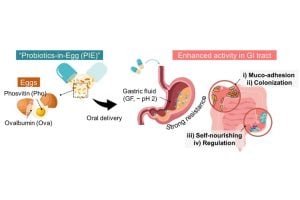
That expensive probiotic capsule you’re taking is probably not doing much good. Most of the live bacteria in commercial products are killed by stomach acid before they even reach your intestines. But Johns Hopkins engineers have developed a solution: wrapping probiotics in an egg-inspired coating that shields them from destruction, delivering them alive to your gut. The team’s “Probiotics-in-Egg (PIE)” method is described in Advanced Healthcare Materials.
“This innovation significantly improves the survival of probiotics in the gastrointestinal tract, enhances their adhesion to the gut, and provides nutrients for colonization, which all improve the effectiveness of probiotics,” said team member Sangmoo Jeong, an assistant professor of chemical and biomolecular engineering at Johns Hopkins Whiting School of Engineering and a core researcher at its Institute for NanoBioTechnology.
The gut microbiome plays a crucial role in regulating the body’s overall health and physiology, including metabolism, neurological, and immune functions. An imbalance in the gut microbiome has been linked to a range of health issues, including obesity, diabetes, inflammatory bowel diseases, certain cancers, and neurological disorders. Probiotics are commonly used to help manage these conditions, but delivering them by mouth can be challenging because they don’t always survive the harsh gastrointestinal environment.
Jeong says that his team’s PIE approach works better than commercial probiotics because its egg-based coating protects the good bacteria inside from the GI environment, helping them reach the lower GI tract intact. The coating is made from two parts of a chicken egg—phosvitin from the yolk, which is highly stable in acidic conditions and resistant to digestive enzymes, and ovalbumin from the white, which is nutrient-rich and has antioxidant properties. The researchers used tannic acid (TA) as a “glue” to hold the capsule together.
Testing PIE in a laboratory setup that simulated the digestive system, the team found that PIE kept a sample of model probiotics alive longer and helped them grow better than unprotected probiotics. It also stuck more easily to the simulated surfaces and delivered more probiotics to the gut in lab mice.
“This egg-inspired encapsulation technology has great potential as a practical and effective platform for oral delivery of probiotics, which can significantly help maintain a healthy gut microbiome,” Jeong said. “We also think that our egg-inspired encapsulation technology can be used for other oral delivery applications, leading to impacts in broader areas.”
For instance, the team is considering expanding the technology to create probiotics that could help diagnose cancer by detecting biomarkers secreted by stomach and colorectal cancers.
“We could make some kind of living sensor for detecting these cancers because studies have already proven that probiotics can be designed to detect colon cancers,” he said.
Sohyeon Park, Sungwon Jung, Geonhui Lee, Erin Lee, Rodger Black, and Jinkee Hong were also contributors in this study funded by the National Institutes of Health and the National Research Foundation. Jeong has also filed a provisional patent for this technology.